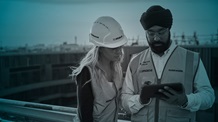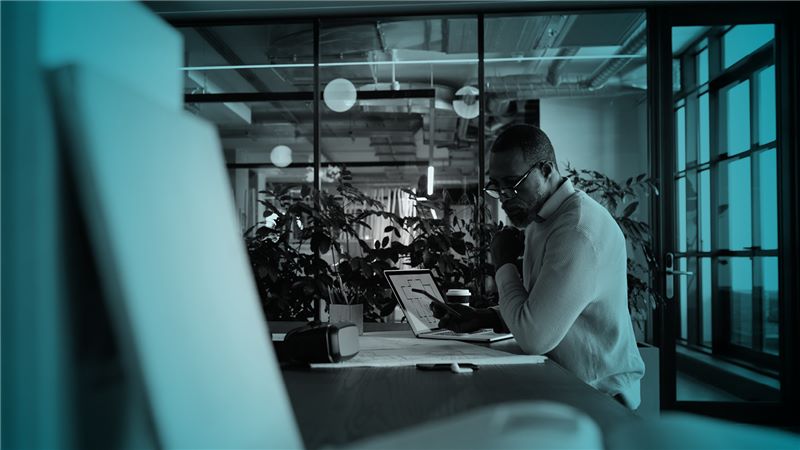The future of the workplace
It is now obvious to everyone that the workplace will never be the same again. The impact of the coronavirus has fundamentally changed our relationship with the workplace – even once offices across the world re-open, we won’t be going back to normal.
In January, if you had asked most businesses or organisations whether they could provide remote working facilities for their entire workforce in less than a week, they would have told you it was impossible. Most companies did not have the technology, the infrastructure or the culture in place to enable remote working for even half their employees.
Three months later and the world has changed significantly. Lockdown has shown everyone that remote working is not just a possibility – it often makes teams more productive.
Corporate occupiers and estates teams are now urgently reviewing their strategies and business plans to establish what the future looks like for their business. In the UK, in April, 49.2% of all working age adults were working from home – compared with just 5.1% who reported working ‘mostly from home’ in 2019.
In Mace’s latest ‘Navigating a New World’ report, we explore the future of the workplace. Drawing on expertise from across our business and a virtual roundtable held with some of the world’s leading corporate occupiers, we explore the key challenges facing developers, occupiers and contractors – and lay out a series of key recommendations to ensure we can all adjust to the new normal.
The scope for change
2019 was a record setting year for global corporate real estate investment. Across the world, investors committed more than $800bn dollars to building and buying commercial space, a rise of 4% since 2018. Although market conditions varied across the globe – London suffered a drop in investment due to concerns over Brexit, while the APAC region flourished – there was little doubt that the market was strong and that commercial real estate was more important than ever.
Now, the world looks very different. The rise of remote working has forced companies to review decades-old assumptions about their workplace requirements and has begun to raise fundamental questions about what the office is actually for. A Gartner survey of Chief Financial Officers found that more than three quarters were planning to make at least 5% of their employees permanent remote workers, reducing costs and enabling greater mobility of the workforce. A quarter of those surveyed said that they will be moving more than a fifth of their entire workforce to permanent remote working.
It is not yet clear what those changes will mean for the real estate market or the future of the office – but polling data now consistently shows that most people believe that their jobs will become more flexible in the future and expect to work remotely more often. For global organisations who have built billion-dollar capital investment programmes around carefully calculated employee/desk ratios, this requires a total reassessment of their strategy – which will in turn drive huge economic changes across the globe.
For occupiers, contractors, consultants and facilities management teams, there are now three core challenges that will define the future of the workplace and how the sector will function over the next five years.
1. Today’s challenge: making workplaces safe and secure
In the short term, offices and workplaces are beginning to open world-wide – but standards and regulations across the globe are inconsistent and many teams are struggling to build a comprehensive strategy that will ensure people are - and crucially, feel - safe when they return to their workplaces.
With big investment required and a successful re-opening likely to shape the experience of employees moving forward, this is a vital step towards establishing a new normal.
Drawing on the expertise of our consultancy, operations and corporate interiors team, Mace has identified four key areas that must be considered as offices and workplaces open over the coming weeks and months:
| Prepare your building | The welcome experience |
|
Is your building ready for safe occupation? Does it meet |
How do employees and visitors feel in their workplace? How |
| Building systems Managing people flow Capacity assessment Touch points Local governance Signage |
Front of house team |
| The new office configuration | Building operations |
| How does the new office operate? Is everyone still working productively and effectively? |
How does the day-to-day operation of the building need to change? Do you have the right procedures and processes in place? |
| Creating a new type of workspace Enhancing desks Workplace ambassadors Reconfiguring meeting rooms Making communal spaces safe |
Cleaning regimes Onsite facilities Restaurants and canteens Refreshment points Security Mail room Waste removal |
2. Tomorrow’s challenge: answering key questions about the workplace
When Mace held a virtual roundtable with our strategic clients about the future of the workplace in a post-pandemic world, views were mixed. Everyone was clear that they would be reviewing and reconsidering their strategies, but few had established what that would mean in practice.
The vast majority of attendees admitted that they believe they would need less space than they did before coronavirus; a finding that is matched by wider surveys we’ve carried out with clients. So will we see a huge surge in organisations divesting themselves of expensive office accommodation?
Possibly. But maybe not. All of our research has shown there isn’t yet much agreement on how much space to lose, or what it is important to keep. Part of that is because organisations are not yet clear what the workplace is actually for in the new world– and that’s something that will differ for each team, between organisations and between different regions.
- Who is it for?
The reality is that we will still need offices – people need to interact with each other in person. For new starters and younger people, for example, face-to-face contact is vital to ensure that people can learn and develop an understanding of the business they’re in. There are also cultural considerations – how do you ensure consistent employee experience if people aren’t regularly attending an office?
Even for long-established and experienced employees, long term remote working can be lonely, with many people reporting that they fear becoming isolated without seeing their colleagues face to face.
- What is it for?
The risk is that organisations may cause themselves long-term difficulties by disposing of good quality corporate real estate too enthusiastically. Instead, companies must carry out detailed data-driven investigations into how they will use their space in the future before making radical decisions about their long-term investment programmes.
Flexibility for workplaces will be critical, both in terms of serving the new needs of employees but also in case of further restrictions or lockdowns if coronavirus or another pandemic re-emerges in the future.
Occupiers will need to establish how much that flexibility matters to them and how much space they will need. The use of smart data on office utilisation will be crucial in monitoring changes to worker behaviour as offices re-open across the globe.
- Where does it need to be?
Alongside reducing their office spaces, we also need to consider where our workplaces need to be. One impact of coronavirus has been a re-think of the commute – it appears that many people are now changing their priorities when it comes to where they live.
That may mean that companies reduce their estates in big global hubs but invest in smaller satellite offices giving their people the ability to live in cheaper locations and travel occasionally to smaller sites when they need to meet with colleagues.
This would be a reverse of many of the major estate rationalisation programmes that have been taking place across the public and private sector over the last decade. That will come with it’s own difficulties – how do organisations quickly and effectively reverse their approach and create satellite offices? Shared office services – often considered to be a sector that is likely to suffer because of the pandemic – would be one solution.
One thing is clear – there is a long way to go before a coherent vision for the office and workplace becomes apparent. In the interim, we will see plenty of change as different organisations adopt and iterate new strategies.
3. Our future challenge: the shape of our cities
As companies shape their strategies for the future, shift their investment focuses and begin to re-imagine the future of the workplace, we will begin to see huge shifts in how we live and how our cities are built.
Global hub cities are shaped by commercial real estate, with central business districts attracting huge volumes of capital investment and driving regional policy and decision making. A city like London or New York is the centre of gravity for millions of commuting workers, with their influence extending far across the surrounding regions. The average commuter in London and New York spent more than 80 minutes a day on their journey to and from work before the pandemic. If the post-pandemic world will see more of us work remotely and commuting less, then what happens to our cities?
Some changes will happen quickly. Limitations on transport capacity and social distancing rules are already producing innovative policies, such as Rotterdam’s use of parking spaces across the city as outside dining and drinking areas for bars and restaurants.
Some will be slower. The viability of dense office development areas, such as Canary Wharf in London or La Défense in Paris, is likely to change and that will have an impact on how we develop and build commercial real estate.
Housing values will shift, as outside space becomes more important and separate working spaces become more valuable for people who will be visiting the office less. It is easy to imagine a fresh wave of ‘garden city’ investment coming forward as part of national recovery plans – but for the first time the size and location of these may be less reliant on easy commuting distances to city centres.
More importantly, if we do find that occupiers are reducing their estates significantly, cities and towns will need to find radical solutions to huge swathes of office space that are surplus to requirements. How quickly can un-let corporate real estate be repurposed into housing? Will cities find new ways to draw people back to the centre?
Recommendations
We are on the verge of a tremendous re-alignment of the commercial real estate market – and like any market realignment there will be those who benefit and those who miss out.
That means that corporate occupiers, developers, governments and companies working in the built environment need to be developing their new strategies now. Those who adapt quickest to the new normal will open up opportunities denied to those who take longer to come to terms with the impact of coronavirus.
In order to support that process, Mace has laid out a series of recommendations that we believe are critical to shape the future of the workplace:
| Short term | Medium term | Long term |
| Follow guidance to ensure that all workplaces are COVID-19 secure and meet regulations. |
Develop and agree new workplace strategies that are flexible and can respond to change. |
Work with stakeholders to understand how cities and regions will change in the future. |
| Communicate regularly with employees to ensure that they feel safe in the workplace. |
Regularly review utilisation of existing assets to identify workplace trends as they develop. |
Establish a 'horizon scanning' team to quickly adapt to changing regulations and circumstances. |
| Carry out detailed data-driven analysis of where and how people can effectively work. |
Ensure employees are engaged and feel vested in how their workplace and experience is changing. |
Be prepared to consider radical solutions, including relocating offices and switching operating models. |













